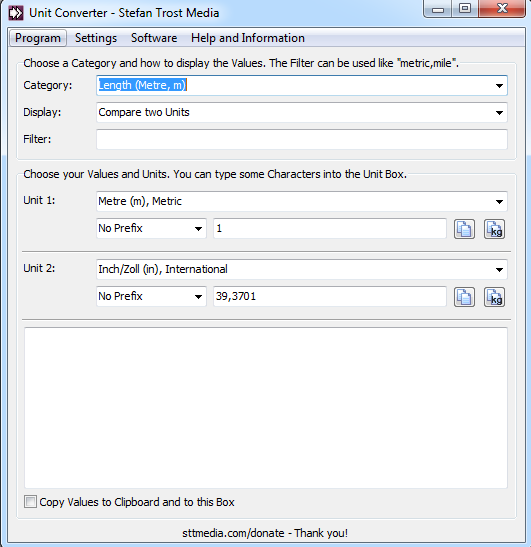Unit Converter (Windows)
Informatie (ENG):
With the help of the Unit Converter you can convert over 4500 units from 33 categories such as length, area, volume, mass, density, temperature, time, speed, acceleration, volume flow, kitchen measurements, information and storage, quantity, shoe size, energy, power, force, torque, pressure, frequency, electromotive force, electric current, electric charge, electrical resistance, luminous intensity, luminance, illuminance, radiation activity, radiation exposure, absorbed dose, radiation equivalent doese, angle and amount of substance (here you can get an overview). In addition it is possible to add custom units without any problems. The user defined units can be added to one of the existing categories or you can define your own new category for your units (here is an introduction to this topic).
To get the most out of the Unit Converter, you can use the tool in different modes. According to your application, you can show a complete table of all units available, you can compare only two or three units and you can show or hide units for comparisons. Also searching for units is very easily: Usually, it is only neccessary to type in some characters from the unit or the system of the unit to reduce the range of units. With this, it is easier to select a unit, because you do not have to go through hundrets of units. Furthermore, you can also define global filters for which also only a few characters have to be typed in. Such a global filter can look like “metric,mile,inch” to compare the units mile and inch with metric measurements.
Behind usually units like metre, kilogram or pound, there are also a great number of other, unusually units available in the Unit Converter. For instance, antique measurements, units from countries all over the world or comparison values. With this comparison values you can check how many soccer fields (or countries) is an area or how many elephants someone weights. In addition, you can add prefixes like nano-, micro- or kilo- to each of the units. With this you can also convert values within one unit, for example micrometres to petametres.
Furthermore, there are lots of settings that can be adjusted. For example, you can choose, whether the Unit Converter should search for the best fitting prefix for a value, whether you want to display the values as fractions or as floating point values, the format of numbers (decimal places, exponential notation and so on) or in which format and with which characters the values should be copied to the clipboard, so that you can insert the values directly in the correct format in another context. Of course, you can save all of these settings and if you want, they can be loaded automatically when starting the tool.



